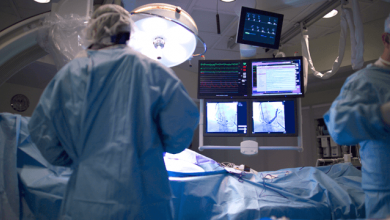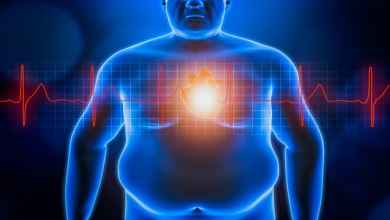Search results
Author(s):
Moinuddin Choudhury
,
Mark R Boyett
,
Gwilym M Morris
Added:
3 years ago
The sinoatrial or sinus node (SAN) is the heart’s natural pacemaker. Located in the superior right atrium, it automatically produces cyclical electrical activity to initiate each heartbeat in normal sinus rhythm. SAN dysfunction (SND) in humans, also known as ‘sick sinus syndrome’, can manifest as pathological bradycardia and asystolic pauses. As a result, SND can lead to symptoms of reduced…
View more
Author(s):
Dario DiFrancesco
Added:
3 years ago
HCN4 (hyperpolarisation-activated, cyclic nucleotide gated 4) channels, the pore-forming α–subunits of ‘funny’ channels originally described in pacemaker cells of the sinoatrial node (SAN),1 are responsible for the early phase of diastolic depolarisation in these cells and are key determinants of pacemaker generation and control of heart rate.2–5 HCN4 channels are selectively expressed in the SAN…
View more
Author(s):
Sharon A George
,
N Rokhaya Faye
,
Alejandro Murillo-Berlioz
,
et al
Added:
3 years ago
More than 100years have passed since the atrioventricular node (AVN) was first discovered by Sunao Tawara1 and described as a “Knoten” of tissue located at the proximal end of the Bundle of His (BoH).2 Despite the numerous advances in knowledge regarding the structure and function of the AVN, there are still several controversies that need to be addressed in both clinical and scientific settings…
View more
Author(s):
Mahmoud Abdelnabi
,
Ashraf Ahmed
,
Abdallah Almaghraby
,
et al
Added:
3 years ago
Ivabradine is a pure heart rate-lowering agent best characterised by its negative chronotropic effect on the sinoatrial node.1 Its unique mechanism selectively blocks the pacemaker funny (If) channels, which are responsible for spontaneous depolarisation in the sinoatrial node that regulates heart rate during sinus rhythm (Figure 1).2 Since 1980, it has been well established that controlling the…
View more
Author(s):
Demosthenes G Katritsis
Added:
3 years ago
Since the identification of the hyperpolarisation-activated cyclic nucleotide channel 4 (HNC4), a major constituent of the pacemaker current (If) in the sinoatrial node, as a modulator of heart rate,1 several genetic causes of sinus bradycardia by means of mutations in ion channel encoding genes have been described. They may result in isolated sick sinus sydrome or other arrhythmia and…
View more
Author(s):
Rohil Bedi
,
Ali Ahmad
,
Piotr Horbal
,
et al
Added:
7 months ago
Unmasking Adenosine
Author(s):
Gareth DK Matthews
,
Andrew Grace
Added:
3 years ago
Article
Author(s):
Zhao Liu
,
J Kevin Donahue
Added:
3 years ago
In the United States, atrial fibrillation (AF) is the most common sustained cardiac arrhythmia affecting approximately six million patients and contributing to a greatly increased risk of stroke, heart failure (HF) and overall morbidity and mortality.1,2 The prevalence of AF is increasing as the average age of the population increases.3,4
Currently available therapies for AF are suboptimal…
View more
Author(s):
Riyaz Kaba
,
Omar Ahmed
,
Elijah R Behr
,
et al
Added:
1 year ago















